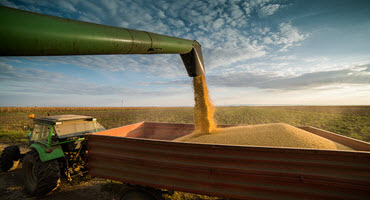Farmers in North Carolina have completed their 2017 corn harvest
By Diego Flammini
News Reporter
Farms.com
U.S. corn producers have completed more than 80 percent of their 2017 harvest, according to the U.S. Department of Agriculture’s (USDA) Weekly Weather and Crop Bulletin for the week ending Nov. 12.
Farmers have combined 83 percent of the 2017 U.S. corn crop, according to the report. That number is up from 70 percent last week.
But the corn harvest is still 9 percent behind last year’s harvest completion at this time.
Farmers in North Carolina have finished their 2017 corn harvest.
Growers in Wisconsin have completed 56 percent of their corn harvest. That number is the lowest among the 18 states documented but does represent a 19 percent increase from last week.
Soybeans
The American soybean harvest increased by 3 percent from last week, according to the USDA’s report.
Farmers have combined 93 percent of the American soybean crop as of Nov. 12. That number is up from 90 percent last week but slightly below the 96 percent harvest completion measured at this time last year.

Producers in Louisiana and Minnesota have finished their soybean harvest.
Soybean producers in North Carolina have completed 54 percent of their soybean harvest. That number is the lowest of the 18 states recorded but does represent a 4 percent increase from last week. The state’s soybean harvest is still 14 percent behind its harvest completion recorded at this time last year.
Wheat
U.S. winter wheat emergence rose by 9 percent over the last week.
About 84 percent of the total U.S. winter wheat crop has emerged, according to the USDA. That number is up from 75 percent last week.

In South Dakota, 97 percent of the state’s winter wheat crop has emerged. That number is up from 95 percent last week and is the highest among the 18 states documented.
About 20 percent of the winter wheat crop in California has emerged. That number is up from 12 percent last week but well below last year’s figure of 44 percent emergence.
USDA ranked 46 percent of the winter wheat crop as good.
Suitable fieldwork days
Nevada, Arizona, Massachusetts and Connecticut had the most suitable fieldwork days (seven) for the week ending Nov. 12, according to the USDA.
Montana had the fewest suitable fieldwork days (2.3) during the same week.
Weekly precipitation levels
State | Weekly Precipitation (in inches) | Weather Station |
Illinois | 0.11 | Springfield |
Indiana | 1.20 | Indianapolis |
Iowa | 0.04 | Burlington |
Kentucky | 1.40 | Paducah |
Michigan | 0.21 | Lansing |
Missouri | 1.07 | Saint Louis |
New York | 2.13 | Buffalo |
Pennsylvania | 3.09 | Erie |
Tennessee | 3.48 | Nashville |
The next Weekly Weather and Crop Bulletin will be released on Tues., Nov. 21.